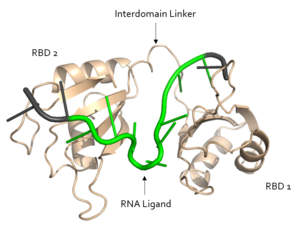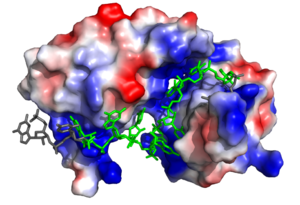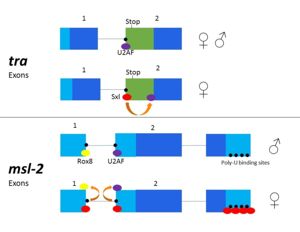User:Kyle Burton/Sandbox1
From Proteopedia
(Difference between revisions)
| Line 2: | Line 2: | ||
== Background == | == Background == | ||
[[Image:Sex Lethal Protein Structural Overview with Labels.png|300px|right|thumb| '''Figure 1.''' Structural overview of Sxl. RNA ligand colored in green is recognized and bound, RNA ligand colored in grey is not bound. Structure shown is [https://www.rcsb.org/structure/1b7f PDB:1b7f]. Figure created in PyMol.]] | [[Image:Sex Lethal Protein Structural Overview with Labels.png|300px|right|thumb| '''Figure 1.''' Structural overview of Sxl. RNA ligand colored in green is recognized and bound, RNA ligand colored in grey is not bound. Structure shown is [https://www.rcsb.org/structure/1b7f PDB:1b7f]. Figure created in PyMol.]] | ||
| - | '''Sex Lethal Protein''' (Sxl) is an important splicing repressor in the male developmental pathway and [https://en.wikipedia.org/wiki/Sex-determination_system sex determination] of the common fruit fly, ''[https://en.wikipedia.org/wiki/Drosophila_melanogaster Drosophila melanogaster]''<ref name="Handa">PMID: 10217141</ref>. Sxl regulates [https://en.wikipedia.org/wiki/Alternative_splicing alternative splicing] pathways to promote the expression of female sex-linked proteins. In eukaryotes, splicing is carried out via the [https://en.wikipedia.org/wiki/Spliceosome spliceosome], a [https://en.wikipedia.org/wiki/Ribozyme ribozyme]-protein complex which binds to the 5’ and 3’ splice sites. Sxl prevents the binding of the [https://en.wikipedia.org/wiki/U2AF2 U2AF] and [https://en.wikipedia.org/wiki/U1_spliceosomal_RNA U1 subunits] of the spliceosome at their respective splice sites, which represses their alternative splicing pathways<ref name="Penalva">Penalva L, Sanchez L. RNA Binding Protein Sex-Lethal (Sxl) and Control of Drosophila Sex Determination and Dosage Compensation. Microbiol Mol Biol Rev.;67(3):343-356. doi: 10.1128/MMBR.67.3.343–359.2003</ref>. As a result, the fruit fly expressing Sxl will produce mRNA transcripts encoding proteins for the female developmental pathway<ref name="Handa"/>. If Sxl is unable to repress translation of the male-sex lethal ( | + | '''Sex Lethal Protein''' (Sxl) is an important splicing repressor in the male developmental pathway and [https://en.wikipedia.org/wiki/Sex-determination_system sex determination] of the common fruit fly, ''[https://en.wikipedia.org/wiki/Drosophila_melanogaster Drosophila melanogaster]''<ref name="Handa">PMID: 10217141</ref>. Sxl regulates [https://en.wikipedia.org/wiki/Alternative_splicing alternative splicing] pathways to promote the expression of female sex-linked proteins. In eukaryotes, splicing is carried out via the [https://en.wikipedia.org/wiki/Spliceosome spliceosome], a [https://en.wikipedia.org/wiki/Ribozyme ribozyme]-protein complex which binds to the 5’ and 3’ splice sites. Sxl prevents the binding of the [https://en.wikipedia.org/wiki/U2AF2 U2AF] and [https://en.wikipedia.org/wiki/U1_spliceosomal_RNA U1 subunits] of the spliceosome at their respective splice sites, which represses their alternative splicing pathways<ref name="Penalva">Penalva L, Sanchez L. RNA Binding Protein Sex-Lethal (Sxl) and Control of Drosophila Sex Determination and Dosage Compensation. Microbiol Mol Biol Rev.;67(3):343-356. doi: 10.1128/MMBR.67.3.343–359.2003</ref>. As a result, the fruit fly expressing Sxl will produce mRNA transcripts encoding proteins for the female developmental pathway<ref name="Handa"/>. If Sxl is unable to repress translation of the male-sex lethal (Msl-2) protein in female flies, the female fly will die due to hyperexpression of both X chromosomes<ref name="Black">doi: 10.1146/annurev.biochem.72.121801.161720</ref><ref name="Georgiev">PMID: 21339706</ref>. |
Sxl targets the ''transformer'' (''tra'') and ''msl-2'' primary transcripts. Tra is a splicing activator for the female developmental pathway, and ''msl-2'' expression modulates [https://en.wikipedia.org/wiki/X_chromosome X chromosome] application in male fruit flies. The mechanism for how Sxl targets these pathways differs slightly. In both mechanisms, Sxl occupies the 3' splice site and prevents [https://en.wikipedia.org/wiki/U2AF2 U2AF] from binding. This causes the U2AF splicing factor to bind at a downstream splice site encoding proteins in the female developmental pathway. In ''msl-2'' targeting, Sxl also blocks the binding of another regulatory splicing factor, Rox8, and the [https://en.wikipedia.org/wiki/SnRNP U1 snRNP] at the 5’ splice site<ref name="Penalva"/>. Sxl can also control its own splicing pattern to conserve female expression. It does so by binding to [https://en.wikipedia.org/wiki/Exon Exon] 3 of its own RNA and creating an RNP complex to eliminate this exon. After removal of Exon 3, Sxl becomes active and female expression is maintained. | Sxl targets the ''transformer'' (''tra'') and ''msl-2'' primary transcripts. Tra is a splicing activator for the female developmental pathway, and ''msl-2'' expression modulates [https://en.wikipedia.org/wiki/X_chromosome X chromosome] application in male fruit flies. The mechanism for how Sxl targets these pathways differs slightly. In both mechanisms, Sxl occupies the 3' splice site and prevents [https://en.wikipedia.org/wiki/U2AF2 U2AF] from binding. This causes the U2AF splicing factor to bind at a downstream splice site encoding proteins in the female developmental pathway. In ''msl-2'' targeting, Sxl also blocks the binding of another regulatory splicing factor, Rox8, and the [https://en.wikipedia.org/wiki/SnRNP U1 snRNP] at the 5’ splice site<ref name="Penalva"/>. Sxl can also control its own splicing pattern to conserve female expression. It does so by binding to [https://en.wikipedia.org/wiki/Exon Exon] 3 of its own RNA and creating an RNP complex to eliminate this exon. After removal of Exon 3, Sxl becomes active and female expression is maintained. | ||
| Line 8: | Line 8: | ||
== Structure == | == Structure == | ||
| - | [[Image:Sex lethal protein electrostatic surface representation.png|300px|left|thumb| '''Figure 2.''' | + | [[Image:Sex lethal protein electrostatic surface representation.png|300px|left|thumb| '''Figure 2.''' Sxl showing the electropositive binding pocket and the bound RNA ligand. Pre-mRNA residues binding to Sxl shown in green, non-binding residues shown in grey. Structure shown is [https://www.rcsb.org/structure/1b7f PDB:1b7f]. Figure created in PyMol.]] |
Sxl is composed of two asymmetric RNA binding domains (RBD1 and RBD2) which recognize a poly-uridine site in the pre-mRNA transcript<ref name="Handa"/>. Each RBD is comprised of two [https://en.wikipedia.org/wiki/Alpha_helix alpha helices] and one antiparallel four-stranded [https://en.wikipedia.org/wiki/Beta_sheet β sheet]<ref name="Handa"/> containing the [https://en.wikipedia.org/wiki/RNA_recognition_motif RNA recognition motif](Fig. 1). The β sheets face each other, lining the V-shaped cleft<ref name="Handa"/>, shown in sand in Fig. 1. The inter-domain linker, shown in sand in Fig. 1, forms a distorted 3<sub>10</sub> helix which helps form the V-shaped cleft into which the pre-mRNA sequence binds<ref name="Handa"/><ref name="Black">doi: 10.1146/annurev.biochem.72.121801.161720</ref>. Sxl binds to UGUUUUUUU sequence of GUUGUUUUUUUU in the ''tra'' pre-mRNA<ref name="Handa"/><ref name="Black"/>. RBD1 binds U6-U11 and RBD2 binds U3, G4, and U5. Figure 1 shows bound pre-mRNA residues in green and non-bound pre-mRNA residues in grey. Although the two RBDs do not interact with each other, this nine-ribonucleotide sequence must be recognized continuously to allow Sxl to bind, preventing U2AF from binding at the 3’ splice site<ref name="Handa"/>. The binding of Sxl to the pre-mRNA occurs in an electropositive pocket (shown in blue in Fig. 2) due to extensive interactions with the RNA phosphate backbone and negatively charged residues<ref name="Handa"/>. Since Sxl binds primarily with the phosphate backbone, the protein residues are not highly conserved. | Sxl is composed of two asymmetric RNA binding domains (RBD1 and RBD2) which recognize a poly-uridine site in the pre-mRNA transcript<ref name="Handa"/>. Each RBD is comprised of two [https://en.wikipedia.org/wiki/Alpha_helix alpha helices] and one antiparallel four-stranded [https://en.wikipedia.org/wiki/Beta_sheet β sheet]<ref name="Handa"/> containing the [https://en.wikipedia.org/wiki/RNA_recognition_motif RNA recognition motif](Fig. 1). The β sheets face each other, lining the V-shaped cleft<ref name="Handa"/>, shown in sand in Fig. 1. The inter-domain linker, shown in sand in Fig. 1, forms a distorted 3<sub>10</sub> helix which helps form the V-shaped cleft into which the pre-mRNA sequence binds<ref name="Handa"/><ref name="Black">doi: 10.1146/annurev.biochem.72.121801.161720</ref>. Sxl binds to UGUUUUUUU sequence of GUUGUUUUUUUU in the ''tra'' pre-mRNA<ref name="Handa"/><ref name="Black"/>. RBD1 binds U6-U11 and RBD2 binds U3, G4, and U5. Figure 1 shows bound pre-mRNA residues in green and non-bound pre-mRNA residues in grey. Although the two RBDs do not interact with each other, this nine-ribonucleotide sequence must be recognized continuously to allow Sxl to bind, preventing U2AF from binding at the 3’ splice site<ref name="Handa"/>. The binding of Sxl to the pre-mRNA occurs in an electropositive pocket (shown in blue in Fig. 2) due to extensive interactions with the RNA phosphate backbone and negatively charged residues<ref name="Handa"/>. Since Sxl binds primarily with the phosphate backbone, the protein residues are not highly conserved. | ||
| Line 36: | Line 36: | ||
=== Autoregulation === | === Autoregulation === | ||
| - | Sxl is capable of autoregulation of its expression<ref name="Black"/>. Sxl protein autoregulates negatively by binding the poly-U sequence in its own 5'UTR, repressing translation<ref name="Black"/>. The negative autoregulation results in maintaining appropriate concentrations of Sxl. Sxl can also positively autoregulate its expression: the Sxl gene is transcribed in male flies, but the inclusion of exon 3 results in a premature stop codon, producing an inactive, truncated protein<ref name="Black"/>. The same Sxl promoter is active in female flies, but an additional (briefly active) Sxl promoter produces a transcript with exon 3 removed, resulting in an active Sxl protein which will initiate other female-specific splicing cascades<ref name="Black"/>. | + | Sxl is capable of autoregulation of its expression<ref name="Black"/>. Sxl protein autoregulates negatively by binding the poly-U sequence in its own 5'UTR, repressing translation<ref name="Black"/>. The negative autoregulation results in maintaining appropriate concentrations of Sxl. Sxl can also positively autoregulate its expression: the ''Sxl'' gene is transcribed in male flies, but the inclusion of exon 3 results in a premature stop codon, producing an inactive, truncated protein<ref name="Black"/>. The same ''Sxl'' promoter is active in female flies, but an additional (briefly active) ''Sxl'' promoter produces a transcript with exon 3 removed, resulting in an active Sxl protein which will initiate other female-specific splicing cascades<ref name="Black"/>. |
=== ''Tra'' === | === ''Tra'' === | ||
| - | In alternative splicing of the ''tra'' gene, Sxl binds at the 3' poly-uridine site (Fig. 3). This causes U2AF to bind downstream and the ribosome assembles at the following exon<ref name="Penalva"/>. In the absence of Sxl, the normal gene for male development is transcribed. The exon contains a stop codon which results in a truncated, non-functional protein<ref name="Black"/>. In the presence of Sxl, this exon is spliced, so the stop codon is skipped<ref name="Black"/> (Fig. 3). This enables translation of | + | In alternative splicing of the ''tra'' gene, Sxl binds at the 3' poly-uridine site (Fig. 3). This causes U2AF to bind downstream and the ribosome assembles at the following exon<ref name="Penalva"/>. In the absence of Sxl, the normal gene for male development is transcribed. The exon contains a stop codon which results in a truncated, non-functional protein<ref name="Black"/>. In the presence of Sxl, this exon is spliced, so the stop codon is skipped<ref name="Black"/> (Fig. 3). This enables translation of active Tra<ref name="Black"/>, which is vital to female fruit fly development. |
=== ''Msl-2'' === | === ''Msl-2'' === | ||
| - | + | Msl-2 is responsible for [https://en.wikipedia.org/wiki/Dosage_compensation dosage compensation] of X chromosomes in fruit flies. The alternative splicing of ''msl-2'' is reliant on Sxl binding to both the 5' and 3' splice sites (Fig. 3). Sxl binds at the 3' splice site, replacing U2AF as in ''tra'' splicing. Sxl also competes with [http://www.uniprot.org/uniprot/Q26281 Rox8], which binds to the first intron. As a result, Sxl prevents splicing of the first intron of the ''msl-2'' primary transcript<ref name="Georgiev"/>. Sxl also binds to the poly- U sequences of the 3' UTR to repress translation (Fig.3)<ref name="Penalva"/>, leading to female expression. When Sxl targets ''msl-2'', the first intron is retained<ref name="Black"/><ref name="Georgiev"/>. However, the retained intron is in the [https://en.wikipedia.org/wiki/Untranslated_region 5' UTR] and does not affect the reading frame<ref name="Black"/>. When ''msl-2'' is expressed, the X chromosome's transcription is repressed. In male fruit flies, ''msl-2'' must be inactivated to allow increased X chromosome transcription<ref name="Georgiev"/>. As the expression of ''msl-2'' is exclusively required for male fruit fly development, any mutation in Sxl which causes splicing and activation of the ''msl-2'' gene in females leads to female fly death by hyperexpression of both X chromosomes<ref name="Georgiev"/>. | |
== Relevance == | == Relevance == | ||
Revision as of 16:17, 17 April 2018
| |||||||||||
References
- ↑ 1.00 1.01 1.02 1.03 1.04 1.05 1.06 1.07 1.08 1.09 1.10 1.11 1.12 1.13 1.14 1.15 1.16 1.17 1.18 1.19 1.20 1.21 1.22 1.23 Handa N, Nureki O, Kurimoto K, Kim I, Sakamoto H, Shimura Y, Muto Y, Yokoyama S. Structural basis for recognition of the tra mRNA precursor by the Sex-lethal protein. Nature. 1999 Apr 15;398(6728):579-85. PMID:10217141 doi:10.1038/19242
- ↑ 2.0 2.1 2.2 2.3 Penalva L, Sanchez L. RNA Binding Protein Sex-Lethal (Sxl) and Control of Drosophila Sex Determination and Dosage Compensation. Microbiol Mol Biol Rev.;67(3):343-356. doi: 10.1128/MMBR.67.3.343–359.2003
- ↑ 3.00 3.01 3.02 3.03 3.04 3.05 3.06 3.07 3.08 3.09 3.10 3.11 3.12 3.13 Black DL. Mechanisms of alternative pre-messenger RNA splicing. Annu Rev Biochem. 2003;72:291-336. doi: 10.1146/annurev.biochem.72.121801.161720., Epub 2003 Feb 27. PMID:12626338 doi:http://dx.doi.org/10.1146/annurev.biochem.72.121801.161720
- ↑ 4.0 4.1 4.2 4.3 4.4 Georgiev P, Chlamydas S, Akhtar A. Drosophila dosage compensation: males are from Mars, females are from Venus. Fly (Austin). 2011 Apr-Jun;5(2):147-54. Epub 2011 Apr 1. PMID:21339706



